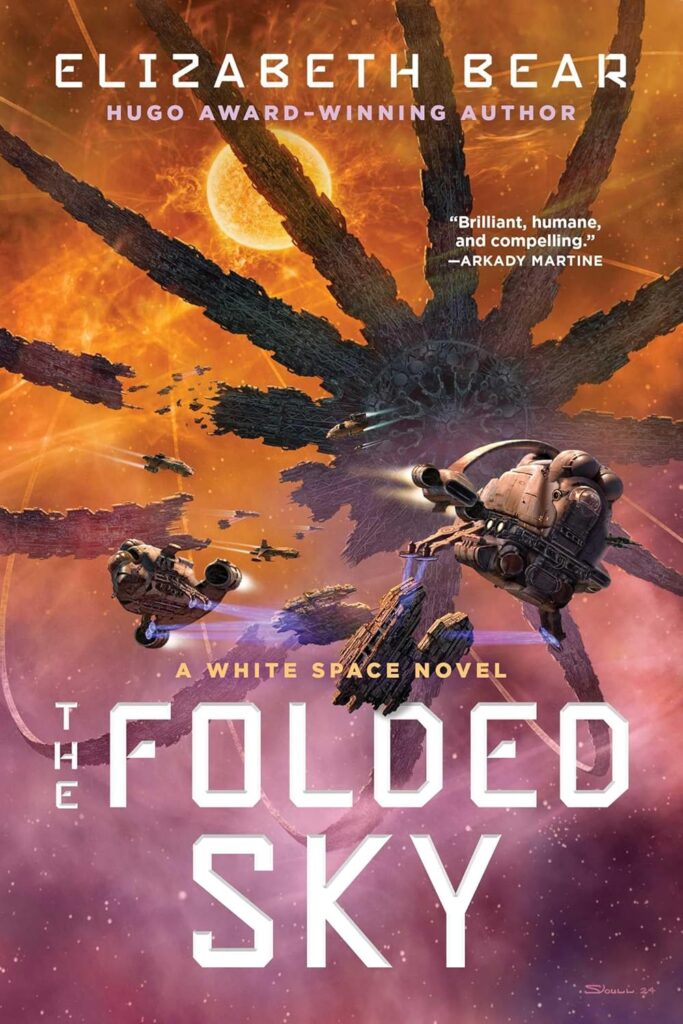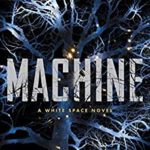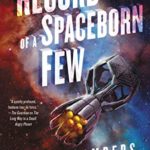Elizabeth Bear’s The Folded Sky, the third novel in her White Space series, tells a stand-alone story, full of grand space opera tropes, including Alcubierre-White drives that fold space for faster than light travel, space pirates, sentient ships, a diverse crew of “syster” species, and a star about to go nova. But it’s not just a good adventure story. It’s an insightful book about family, about dealing with anxiety, information, entropy and efforts to decode a language that sounds to human senses like song.
Dr. Sunyata (Sunya or Sun) Song is an archinformist, an expert in discerning patterns in data and alien languages. She travels to the star called Bao to save what can be learned from the Baomind, a sphere of linked sentient tesserae surrounding the unstable star. On the way, her ship, driven by a disdainful AI named Dakhira, who has little use for humans, is attacked by pirates but saved by a military ship of the Synarche defending the station orbiting the Baomind. In a second attack by another pirate vessel, segments or tesserae of the Baomind itself cause it to explode. Once safely aboard the station, called Town, Sunyata discovers it to be a rickety agglomeration of old ships connected by a transparent “toroidal bubble” like a catwalk with a bouncy floor over the abyss of space.
She happily discovers that her family has arrived just ahead of her. Sun is married to Salvie, a Fercho, who is roughly humanoid in shape, covered with a rubbery glossy black integument, with a set of compound eyes, four single ones and arms with hand-like appendages. The Ferchos are raised either to be aggressive warriors or else brood mothers. Salvie, faced with that choice, decided to leave her home planet. She and Sun, have a strong and happy relationship, complicated somewhat by Sun’s two human children, a rebellious teenage girl and a young boy who still likes being treated like a kid. Unfortunately, Sun’s family arrived in the company of Dr. Victorya Devine.
Vickee is Sun’s nemesis, a narcissistic scholar, also an archinformist, who was Sun’s ex but who exploited her and stole her academic research to make a name for herself. Always one to make herself the center of attention and adept at manipulating people’s vulnerabilities, Vickee is Sun’s polar opposite. Sun is plagued by deep anxiety and panic attacks and has a penchant for setting herself up for ridicule by Vickee. Sun is hypervigilant, and I’ve never encountered a character who literally jumps so often when startled, as she is repeatedly by her encounters on Town.
Sunya, whose point of view we closely follow, has a lot of internal work to do. Even though she has undergone Synarche “rightminding” to balance her inner state, she still has wild bouts of anxiety and panic. And Vickee Devine knows how to push her buttons. While Vickee is clearly the major antagonist Sunya faces, after a while she and her bad actions move a little offstage. The key thing is not so much what Vickee does as Sun’s ability to see Vickee for what she is and complete one aspect of her character arc. Will she be able to stop letting Vickee press all her buttons? In other words, Sun, a study in anxiety and hypervigilance, is, in a sense, her own antagonist and has to learn how to accept herself, her considerable talents and her foibles, so that an impossible narcissist like Vickee can no longer manipulate her.
The White Space universe is governed by the Synarche, an interesting concept in joint leadership “with” or “together” in which multiple species live more or less harmoniously, though species prejudice is not uncommon. The system works with the aid of sentient AIs, each with a name and personality of their own. Town is managed by Yod, a helpful and benevolent AI, who protects the forty or so residents while keeping up repairs on the aging station. Dakhira may resent having to ferry living beings around when drones could do their jobs much more efficiently but carries out their duties conscientiously, safely guiding their ship and Sunya through pirate attacks. Cee runs a Synarche ship that not only protects the others with its weapons but also provides advanced medical care when problems arise. These AIs or synthetic sapients have feelings, as everything that thinks has emotion. “Feelings are an efficient means of processing information; hunches are a way of handling innumerable competing inputs.” So AIs have feelings, but expressing them is entirely a matter of choice.
The protective oversight of the AIs, however, can’t keep the station from its multiple threats. The Bao star could go nova in a vast explosion at any time, taking Town, residents and spaceships with it. Not only are the pirates ready to attack, but they form an effective blockade, keeping new supplies from coming in, at least until a larger force of Synarche ships can arrive. And not only is the jerry-built Town station in need of constant repair, but someone on board has attempted to kill two residents, including Sunya. And then Sunya has her personal confrontations with Vickee. Every meeting of the two is a fraught experience with Sun fighting inwardly to keep herself sane despite the constant attacks on her ego.
Despite all that, Sun manages to focus on her work long enough to make great progress in studying the Baomind, not only organizing its signals in patterns but figuring out what its musical communication means. Helping her with that task is Kell, a flat shiny creature who is one of the tesserae of the Baomind, come aboard Town presumably to help its staff with the job of protecting the mind and ultimately transporting its segments elsewhere to avoid obliteration in a nova explosion. Also helping Sunya is one of the most charming “syster” species in the novel, who goes by the humanized name of Dr. Nonsense. It’s a squid-like creature enclosed in a breathing envelope, about two meters wide and one high, who moves along the Town corridors on moist suckers. It communicates by flaring colorful chromataphores that Sunya’s implants translate to human language, and it has a taste for wildly colorful clothing.
Amid Sunya’s ongoing efforts to organize and decipher Baosong, her frequent and agonizing run-ins with Vickee and the threat of a murderer in their midst, the heart of the story comes back again and again to family and a particular symbol of many generations, Sunya’s family tree, that is, a real tree. This a bonsai encased in its own protective environment that Sun is constantly trying to mend and enhance. In a universe dominated by entropy that ultimately wants to disassemble everything, to let information shake off the order Sun wants to impose, to see stations fall apart and stars to disintegrate, the family tree is a survivor going back five or six generations in the Song family. There is a garden pod on Town where Sunya can open the tree to breathe amid dense foliage as she works on its branches. Her repair of the tree parallels her constant internal work to sustain her relationships with Salvie and her children.
Sunya has a lot of internal work to do. Even though she has undergone Synarche “rightminding” to balance her inner state, she still has wild bouts of anxiety and panic. And Vickee Devine knows how to push her buttons. While Vickee is clearly the major antagonist Sunya faces, after a while she and her bad actions move a little offstage. The key thing is not so much what Vickee does as Sun’s ability to see Vickee for what she is and complete one aspect of her character arc. Will she be able to stop letting Vickee press all her buttons? In other words, Sun, a study in anxiety and hypervigilance, is, in a sense, her own antagonist and has to learn how to accept herself, her considerable talents and her foibles, so that an impossible narcissist like Vickee can no longer manipulate her.
Sunya inserts in her narrative lots of comments about cognitive bias and artificial narrative patterns humans impose on their experience. She is full of ideas about history, information, entropy and narrative disorders, but these seem a natural outgrowth of her work as an archinformist, never an intrusion from the author. As Sun puts it, history is truth, that is, the whole of everything that is and that happens, while stories “whittle truth down until our limited minds can wrap themselves around it.” The story Sunya tells may whittle things down, but the result is a beautiful and thought-provoking novel that strikes a fine balance between character study and action. Since the White Space series isn’t a single connected trilogy, there is no grand ending to wrap up everything. There could well be other novels in this universe, and I hope we’ll get more.





Leave a Reply